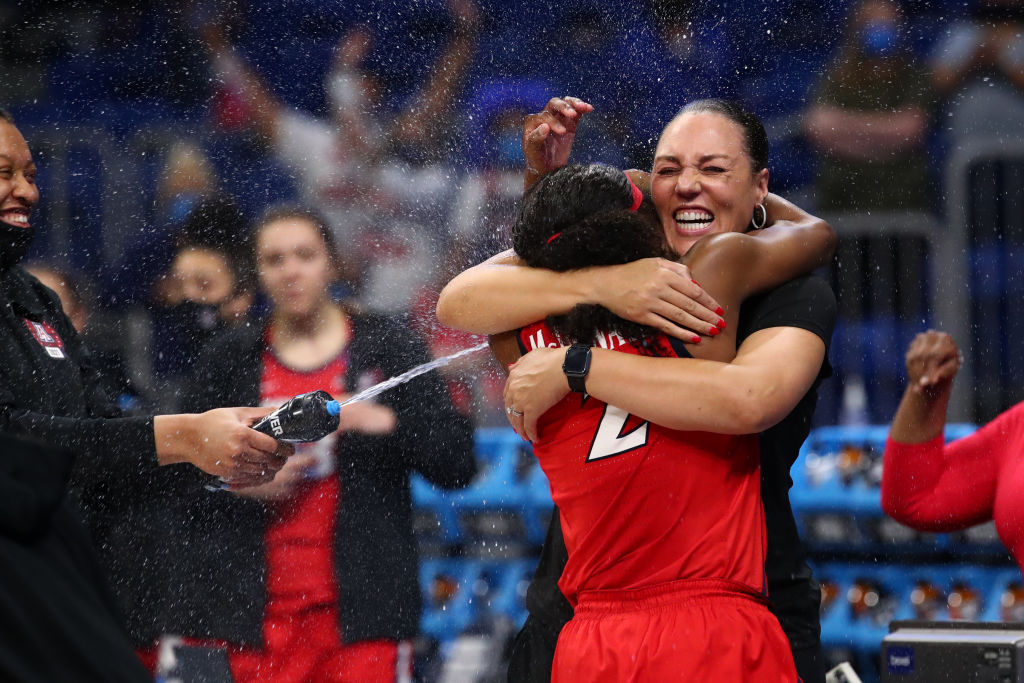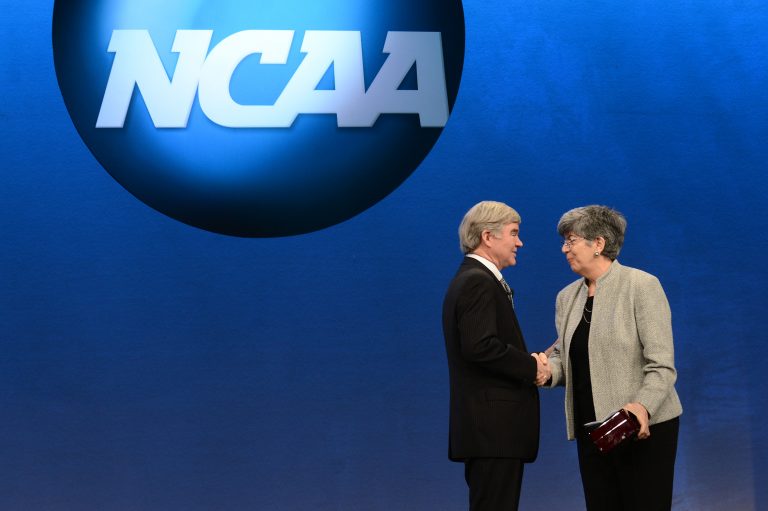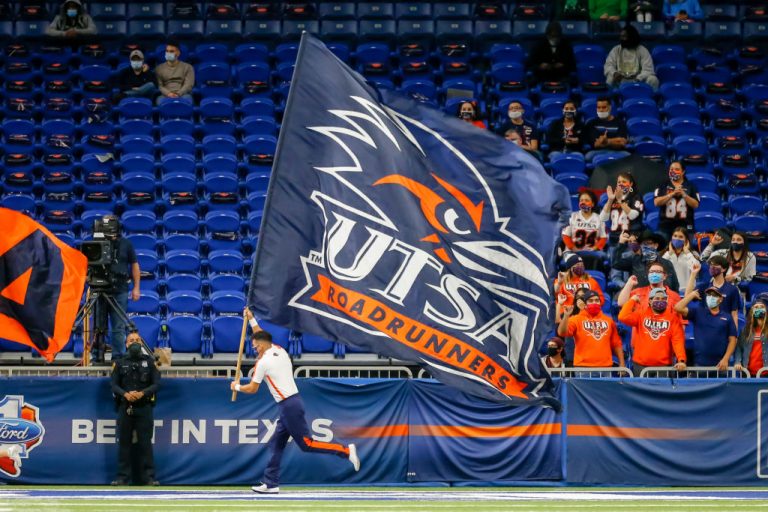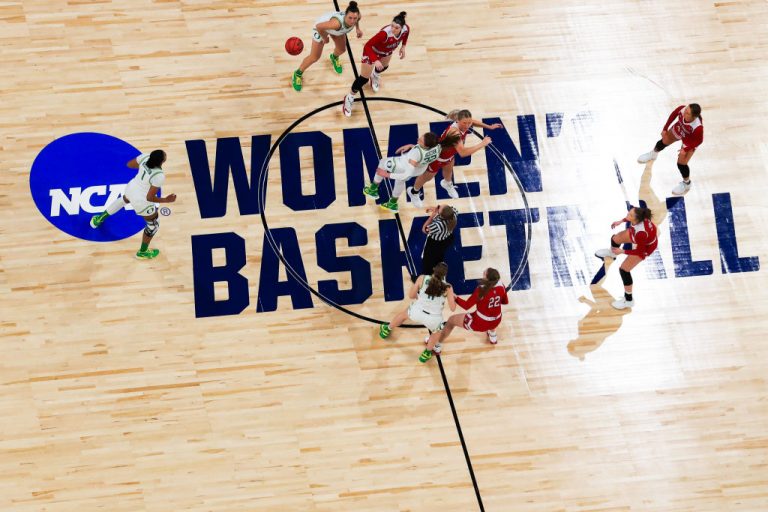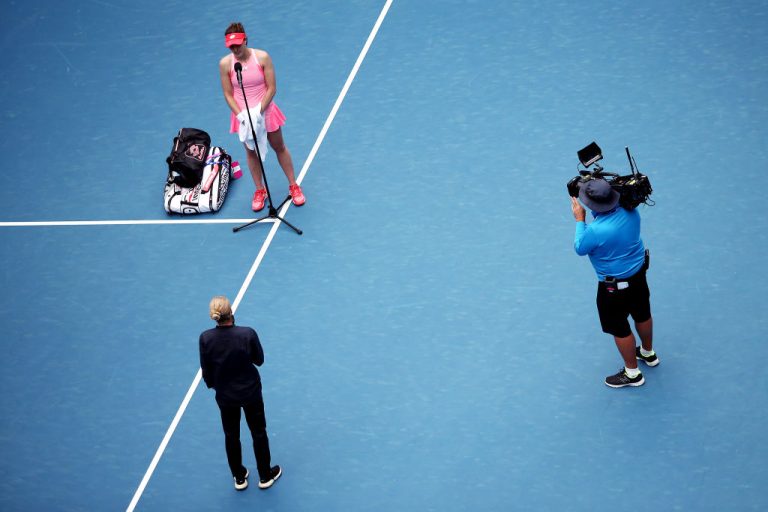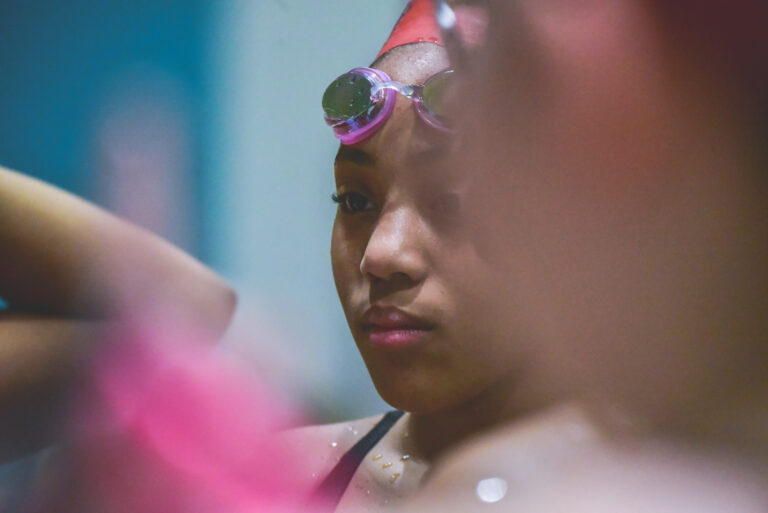More Athletes, Fewer Leaders: The 'Paradox' Facing Women in College Sports
Why this matters
As the 50th anniversary of Title IX approaches, more women are playing college sports than ever before. But the percentages of women coaching women and leading women’s sports are far below their pre-Title IX peaks. Dr. Nicole M. LaVoi, Director of the Tucker Center for Research on Girls & Women in Sport at the University of Minnesota, discusses the reasons for this disparity – and what can be done to address it.
Long before Dr. Nicole LaVoi became a leading scholar of gender in sport looking, she was a 10-year-old elementary school student, unexpectedly called to the principal’s office.
An avid basketball player, LaVoi had just been selected to play on a boys’ travel team. She assumed that her principal wanted to congratulate her.
Instead, she says, the principal asked LaVoi if she would join the Girl Scouts or take up ballet.
“It was because I had displaced a boy on the team,” LaVoi says. “And I said, no, I want to play basketball.”
She laughs.
“I think that is where this all started.”
Today, LaVoi is the director of the Tucker Center for Research on Girls & Women in Sport at the University of Minnesota, which conducts scholarship and outreach focused on understanding and improving sport and physical activity for girls and women.
One of the Tucker Center’s ongoing research projects, the Women in College Coaching Report Card, tracks the percentage of coaches who are women for women’s National Collegiate Athletic Association’s Division I teams. Over time, LaVoi and her fellow researchers have identified a trend: While the number of women playing college sports has increased dramatically, relative opportunities for women to coach have not.
To better understand this phenomenon – and how it connects to a lack of leaders who are women in college sports administration – Global Sport Matters recently spoke with LaVoi. The following interview responses have been lightly edited for clarity and context.
Global Sport Matters: The Tucker Center’s research has consistently found that while opportunities for college athletes who are women have been expanding over time, opportunities for college coaches who are women have not. Broadly speaking, what are the numbers – and what do they tell us?
Dr. Nicole LaVoi: We have a paradox that's operating in college sports. Post-Title IX, the number of participation opportunities for girls and women has gone up. We have a record number of female collegiate athletes today. And we have 50 years of girls and women who have played sports with knowledge, passion, and interest in coaching. So you would think that the percentage of women coaches would have gone up.
In fact, it has gone down. In 1972, there were fewer women playing college sports —but of those who did play, 90 percent were coached by women. Today, that number is around 42 percent. And in that same 50-year span, the percentage of women coaching men has remained remarkably stable at around 3 percent.
Global Sport Matters: So all the change in terms of who athletes are being coached by has been on one side of the gender table?
Dr. Nicole LaVoi: We've been tracking the percentage of women head coaches in [NCAA] Division I across all women’s sports. Over the last 10 years, that has been remarkably stagnant. It might go up or down one or two points, but nothing dramatic.
Global Sport Matters: In what sports are college coaches who are women the most and least underrepresented?
Dr. Nicole LaVoi: So we have a grading system. It’s a fairly generous scale. My students would love it. To get an “A,” you have to have 70 percent of your head coaches of women’s teams be women.
The sports that have consistently gotten “A” grades have been field hockey, equestrian, lacrosse, and rugby. The sports that have gotten F’s and haven’t really moved much over the years are swimming and diving, cross country, track and field, water polo, fencing, and alpine skiing.
There’s one more in there: soccer. It’s teetering on, like, a D-minus. It’s really popular, but there are very few women head coaches.
Global Sport Matters: That’s amazing. You would think that the path to becoming a coach starts with being a player—and since the United States has so many girls and women playing, just over time you would have more women coaches.
Dr. Nicole LaVoi: We can go back to 1999 when the U.S. Women’s National Team won the World Cup. That’s kind of the pinnacle, right? And that just hasn’t translated into having women in positions of power in soccer.
Global Sport Matters: Do we have any idea why certain sports are doing better with this and other sports are not?
Dr. Nicole LaVoi: We do not. We get that question a lot. It’s actually on our list of things to inquire about in our research. What is field hockey doing that cross country isn’t?
While we don’t have data, I can speculate that the answers speak to the culture of the sport you’re looking at, which can be very gendered. Certain sports created cultures where women are valued and supported. Other sports do not.
Global Sport Matters: A new study conducted by the Global Sport Institute at Arizona State University uncovered a similar phenomenon among athletic directors. Examining 385 athletic director changes across 248 NCAA Division I schools between 2010 and 2019, the study found that while women made small gains over that period—rising from 8 percent to 12 percent of athletic directors—the field remains dominated by men.
What kind of connections are there between women being underrepresented in college coaching, and women being underrepresented in athletic director chairs?
Dr. Nicole LaVoi: The correlation between head coaches who are women and the (gender) of the AD is very strong. One of my grad students, Courtney Boucher, looked at that relationship in the Power Five conferences, plus the Big East and American, over a similar timeframe to ASU’s study.
Every time there was a coach hired, we asked, who is doing the hiring? What we found was that male athletic directors are more likely to hire men, and women are more likely to hire women.
Global Sport Matters: Why is that? Is there anything in your research or in other research that explains that phenomenon?
Dr. Nicole LaVoi: One of the theories that we often use is what social scientists call homologous reproduction.
Global Sport Matters: For those of us not regularly reading academic literature at home, what does that term mean?
Dr. Nicole LaVoi: It basically means that people like to hire people like themselves. It's very similar to affinity bias, in which we warm up to people like ourselves. We like to surround ourselves with people who are like us because it affirms our identities – and that’s true for athletic directors, too.
Global Sport Matters: People who work in college sports administration will tell you that people within the industry tend to form professional networks with people who are like them, and that also makes a huge difference in who gets hired.
Dr. Nicole LaVoi: The network piece is really important. I can’t speak to all levels of college sports, but the process by which we hire head coaches at the Division I level is not about who applies for the job. It's about who you know. Athletic directors will pick up the phone and call their network or the people they know. They go out and actively recruit who they think is the best fit. They are not sitting in the offices with stacks of random applications. It just doesn’t work like that.
There’s a narrative that, well, we don’t have a lot of women coaches in women’s sports because they just don’t apply for jobs. That’s really a false argument, because it’s not about applying. It’s about your network.
Global Sport Matters: When you look at the background of who becomes athletic directors, often at some point in their career they were a coach themselves. Is it fair to say that if we have underrepresentation of women coaches, we also are limiting the number of future potential women athletic directors?
Dr. Nicole LaVoi: Yes and no. If you have fewer female coaches, the pathway to athletic director becomes narrower. But the other side of the argument is that many big-time athletic directors currently do not have any coaching background. They come from a business background. Of course, that’s largely dominated by men as well.
Global Sport Matters: The underrepresentation of women in college sports leadership roles has a long history. But, as you mentioned earlier, it’s not the entire history of women’s college sports. In the early 1970s, more than 90 percent of women’s college sports programs were overseen by a female administrator, and more than 90 percent of women’s college sports teams were coached by women.
By 1990, however, those numbers had dropped dramatically. Only 15.9 percent of women’s programs were overseen by administrators who are women, and coaching was below 50 percent. What happened between those years, and why did those numbers change so dramatically?
Dr. Nicole LaVoi: There are multiple explanations. One is that early in the history of women’s college sports, in the 1970s and 1980s, those [leadership] positions were not lucrative. They were not desirable. Lots of them were volunteer positions. They were the old teacher-coach model.
As women's sports gained popularity and visibility and then were taken over by the NCAA, there were more resources. There was more money involved. Coaches of women's teams started to get paid. And in any profession, if there's more prestige and money and power involved, you will find that it becomes male-dominated. Men saw that they had twice the opportunity if they also applied to coach women.
Another reason is the people doing the hiring. There used to be separate college athletic departments for men and women. Women were in charge of women’s sports – but once those departments merged, in most cases, the male athletic director now ran both.
The third reason, I think, is when we’re doing hiring, gender bias comes into play. It’s not just that athletic directors like to hire people like themselves. It’s the idea of what the best qualities and traits are that go along with being a coach. Most of those are aligned with men and masculinity: I’m confident, I’m in control, I can make decisions, I take up physical space, I have a loud voice. We typically think these characteristics make a good coach. And that privileges men. So athletic directors automatically perceive men to be more competent than women, just because they are men.
Global Sport Matters: What if you’re a woman who exhibits those traits?
Dr. Nicole LaVoi: If I am a woman and I am strong, confident, assertive – well, now I’m acting like a man. And exhibiting those masculine characteristics can be perceived as being too masculine, too preachy, too aggressive. As being a [expletive].
It’s a double-edged sword. Women coaches have to walk a fine line between being perceived as highly competent but also being perceived as kind and caring and a nice person, because that is what society’s traditional gender stereotypes tell us women are supposed to be. Men just don’t have to talk that same line.
Global Sport Matters: What career barriers do college coaches who are women face when compared to their counterparts who are men?
Dr. Nicole LaVoi: So many. I mean, they face so many barriers that I’ve written quite a few academic papers about it – and also a book. What we know is that the barriers are complicated and numerous, ranging from social barriers like homophobia, gender bias, racism, and the “mommy penalty” to organizational barriers like the gender pay gap, who is in positions of power, and a lack of family-friendly policies to the interpersonal level of women still doing a majority of the domestic labor and child-caring in their households. Women coaches might have unsupportive partners or a weak social network of support, whereas the men have the old boys’ club.
Global Sport Matters: Data from the Arizona State University Global Sport Institute study indicated that women of color were less likely to become athletic directors than White women. Do women college coaches of color face barriers that their White counterparts do not?
Dr. Nicole LaVoi: Absolutely. It’s the same pattern of intersectionality. Yes, women face more barriers than men. But depending on a woman's intersectional identities – maybe she’s a woman of Color, maybe she’s a gay woman or a queer woman or a mother – she will definitely experience different barriers than her White counterparts.
Global Sport Matters: What are the effects of the underrepresentation of women in leadership – coaches or athletic directors – on both women’s college sports and college sports as a whole?
Dr. Nicole LaVoi: I think the effect in general – that we know from the literature – is that same-sex, same-identity role models matter. One hundred percent of young men get a male coaching role model. A majority of young women don’t.
Having that role model helps young people see a career pathway. You know that women can become athletic directors. You have mentors who can provide insight and guidance. You have a higher self-perception. All of those things help you get to that job.
One question I get a lot is, why should we care about this? Well, evidence tells us that women coached by women are more likely to go into coaching and stay in coaching. We know that gender diversity in the workplace produces a more healthy workplace. We know that when women aren’t token employees and hires, they are more likely to experience better occupational and psychosocial health and well-being outcomes. So there are a lot of reasons why having women in positions of power, whether it’s as athletic directors or as coaches, really matters.
The flip side of this is that it also matters for boys and men. Seeing women in positions of power in sport – an important social institution that a lot of people care deeply about – helps challenge gender stereotypes. We learn to see women as competent leaders in sports, and that challenges the idea that only men should be leaders. It also helps young men treat women as equals. They're not just sexual objects. They're their equals in their workplaces.
Global Sport Matters: The recent NCAA basketball tournament was notable for a series of missteps in which women’s players were treated in a second-class manner, from being prohibited by the NCAA from using the March Madness logo to being outfitted with a paltry dumbbell rack instead of a legitimate weight room. This prompted an avalanche of criticism from inside and outside college sports. People were upset about the disparity in resources between the men’s and women’s tournaments and also upset about the larger lack of investment in women’s basketball as a business and a product worth supporting and growing.
How does underrepresentation of women leaders factor into all of this?
Dr. Nicole LaVoi: Well, it's a well-known fact in the business world that having a diversity of perspectives on one's leadership teams leads to better return on investment and better decision-making. So in most industries, recruiting and retaining diverse talent is a business imperative.
Unfortunately, in sports leadership we are a little behind. Sports have been slow to adopt that mindset. So what we saw with March Madness was not surprising.
One thing that was great is that the athletes themselves were not having it. They aren’t tolerating these kinds of inequities, because they’ve grown up expecting to be treated equally to their male counterparts. They are speaking out and using their platform in powerful ways that we have never seen before.
We’re also seeing a shift in seeing women’s sports as a lucrative business endeavor. You can actually make money with marketing, sponsorships, and investing. One thing we’ve commonly heard from people in power, men in power, is that we’re not going to invest in women’s sports or show them on television because no one is interested. What they’re really saying is that men in positions of power aren’t interested. Because there are a lot of people, myself included, that are very interested in women's sports. There’s a realization that it’s an untapped market.
Global Sport Matters: What can be done to lower barriers and improve college sports leadership opportunities for women?
Dr. Nicole LaVoi: It depends on what level of the system you're looking at. The low-hanging fruit is developing leaders at the individual level. That means providing training and pathways for women. We need to build out robust support networks for women. That includes sponsors, gender allies, and mentors.
The next level is the organizational level. I think that’s where the real sweet spot is, where policies and norms can make a big difference. We need to create work cultures that value and support women.
One of the questions we get all the time is “How do the schools that get As on your report cards hire all these women? Because I can’t find them.” I don’t accept that argument. We interviewed athletic directors at schools with high grades, and the top-level finding was that these athletic directors valued and supported women, and they created cultures where women could succeed and thrive.
Then there’s the societal level. That means changing gender stereotypes, racism, and homophobia. That takes a long time to change.
Global Sport Matters: How confident are you that college sports can or will change when it comes to having more diverse leaders? On one hand, social movements for racial justice and gender equity have been gaining strength in recent years. On the other, college sports have been incredibly stagnant.
Dr. Nicole LaVoi: I'm cautiously optimistic. If I wasn’t, there's no way I could do this work. I do feel there's sort of a tipping point of momentum of really embracing organizational and social change around diversity, equity, and inclusion, and in ways that I don't think have happened before.
Now, with any motion, there’s an opposite motion. Right? As we’re pushing for gender and racial equity – —which is great, and I think we're making a little headway – —there will be some backlash. We have to be prepared for that.
But I do think that the athletic departments that have embraced real social change will be the ones that attract the best talent. It will become a business imperative. The schools that have a culture of valuing diversity, people want to work there. And the schools which, for whatever reason, don’t, I think they will be left behind in the Dark Ages.
Global Sport Matters: When you talk about attracting talent, do you also mean college athletes?
Dr. Nicole LaVoi: Yes. Athletes want to go to a place where they see people like themselves, where they have representation, where they feel valued and safe and included. If you have a coaching staff for all your men’s and women’s teams that is only (made up of) White men, that communicates to this generation of athletes who and what is valued, and what is not.
Monthly Issue
The Administration of Change
Higher education is an environment ripe for discovery, new knowledge, and innovation. However, the role of Athletic Director at university levels still reflect the commonly seen disparities between representation of race, gender, experience, and perhaps most ironically - education level.
Beyond Black and White, what are the underlying factors for the still murky ‘pipeline’ to administrative leadership in U.S. college sport?

